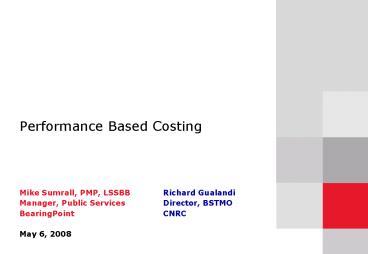Performance Based Costing PowerPoint PPT Presentation
1 / 23
Title: Performance Based Costing
1
Performance Based Costing
- Mike Sumrall, PMP, LSSBB
- Manager, Public Services
- BearingPoint
- May 6, 2008
Richard Gualandi Director, BSTMO CNRC
2
Briefing Outline
- Activity/Performance Based Costing Basics
- Recent success at the Navy Recruiting Command
using CostPerform
3
What is Activity Based Costing (ABC)?
- ABC is a cost management tool that links
resources to activities performed, and activities
to the service and/or product outputs - ABC has been used to help organizations assign
overhead costs to products/services more
accurately than previous costing methodologies to
determine profitability, true net margin, and
process costs - ABC links existing financial, process, workload
and output volume data to accurately determine
cost of products/services - CostPerform ABC models are PBC models
(Performance Based Costing), and provide a clear,
shared understanding of - Outputs and Business Processes
- Output Costs
- Direct, Shared Services, and Sustaining Process
Costs - Process Capacities
- Service delivery costs
- Costs of Outputs
- How Cross-functional Processes Work
4
Building Models with Relevance
- The challenge is to build relevant and useful
cost models. - Costing models must
- Be built with end state in mind What will it
be used for? - Capture real world organizational processes
What is being modeled? - Be constructed iteratively Did you capture
everything? - Report clearly - What is it telling me?
- Be easy to understand - no one ever says, So
what? - Be built with sustainability in mind How hard
is it to maintain? - Enterprise model must capture interdependencies
of organizational models How do changes in X
effect Y?
5
Process Based Costing
The ends or outputs are first
Outputs
Resources
Sub- Processes
Fully-costed Processes
Direct Processes
Budget
Shared service Processes
Sub-processes are the work done in the functions
A unique process creates each service, comprising
work processes
Sustaining Processes
Work processes are of three types
Work flows through the model based on output
quantity and productivity assumptions
6
Dashboards Enable Capacity Planning Scenario
Analyses
- The models built-in dashboard functionality can
be used to easily change volumes and immediately
analyze the impact on the capacity consumption of
the different resources (pools)
Impact of changes to outputs available immediately
Turn knobs to change input parameters
Turn knobs to change input parameters
7
Enterprise Modeling Capability
- Organizational Models can be coupled to form
enterprise models - Enterprise models can be built in parallel or
series
P R O C E S S E S
- budget
- manpower
initial training
education
Outputs
recruiting
distribution
P R O C E S S E S
Organization 1
outputs
Organization 2
Organization 2
8
Performance Based Costing Success at Navy
Recruiting
9
Purpose of the PBC Initiative
- Navy Recruiting wanted to answer these questions
- What is the cost of delivering a Sailor into the
Street to Fleet Supply Chain? - Can you help us capture the costs of the
processes required to deliver a Sailor to the
Fleet? - Can you capture these costs by rating and
designator? - The model answers these questions
Performance Based Costing uses existing data to
provide repeatable financial and effectiveness
information on outputs and processes
10
MPTE Street-to-Fleet Supply Chain
11
Sample of Selected Recruiting Output Costs
- Costs composed of Direct Processes, Program
Support Processes and Overhead - These costs do not include bonuses
- Costs include cost of DEP attrition
Recruiting Costs differ by the type of recruit
Most enlisted ratings cost about 13.5K w/o
bonuses Average cost per recruit delivered to
RTC was 18.7K w/ bonuses
12
Enlisted Nuc MalesNRD Level
Direct Process Costs
Sustaining Process Costs
Shared Services Costs
13
Enlisted Nuc MalesNational Level Pre-DEP
Attrition, Pre-Bonus
14
Enlisted Nuc MalesNational Level Post-DEP
Attrition, Pre-Bonus
15
Enlisted Nuc MalesNational Level Post-DEP
Attrition w/ Bonus
16
Active Duty Officer Costs
- Central program specific support costs drive
recruiting group costs - Most Active Duty Officers cost about 32.5K
- Costs composed of Direct Processes, Program
Support Processes, and Overhead
Specific program management costs drive unit
costs
17
NRD General Enlisted Output Cost Comparison
- NRD costs include recruiting costs, local program
specific costs and local overhead costs only - Salaries normalized to compare process
productivity without cost of living differences
NRD Process Costs vary primarily as a function
of production volume and manning
18
Enterprise Impact of RTC Attrition
1 decrease in RTC attrition saves 100
Enterprise FTEs
21.1K per RTC attrite (Enterprise dollars)
19
RTC Graduates Cost 23K Each
823M was invested in delivering 35.4K RTC
graduates in FY06
20
Use Model to Assess Process Improvement
Initiatives
- Model Allows Us To Test Effectiveness and Cost
Savings from Specific Productivity Improvement
Projects - Example CNRC Process Improvement Team reduced PS
reserve enlisted kit paperwork from 23 to 9 forms
(61) - Estimated time savings from improvement is 5
hours - Equates to saving 1.5M or 21 FTEs per year
- Potentially increases Prior Service PPR from .85
to .88
Quick process improvement analysis validation
21
Highlights System Losses DEP Attrition
- DEP Attrition Cost 108M
- General Enlisted 11,050/Attrite
- NUC Enlisted 15,947/Attrite
- NSW/NSO Enlisted 18,998/Attrite
1 decrease in General Enlisted DEP attrition
saves 3.2M ? 46 FTEs
22
Identifies Capacity Issues -Classifier Quick Look
- Opportunity for benchmarking, personnel
optimization and team reorganization - Classifiers spend an average of 1.25 hours per
applicant - Number assigned ranges from 3 to 11 per NRD
- SEA classifier capacity was 56 hours per recruit,
JAX was 17 hours per recruit
23
Performance Based Costing

